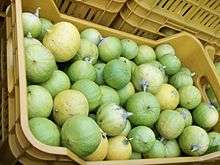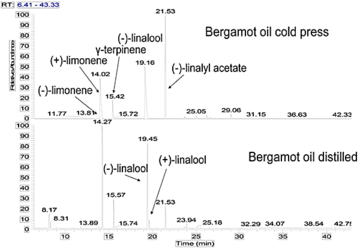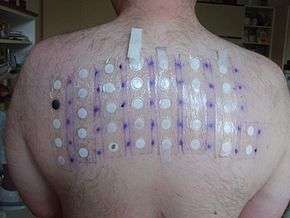Bergamot essential oil

Bergamot essential oil is a cold-pressed essential oil produced by cells inside the rind of a bergamot orange fruit. It is a common top note in perfumes.
Bergamot essential oil is a major component of the original Eau de Cologne composed by Farina at the beginning of the 18th century. The first record of bergamot oil as a fragrance ingredient is from 1714, found in the Farina Archive in Cologne. One hundred bergamot oranges will yield about three ounces (85 grams) of bergamot oil.[1] The scent of bergamot essential oil is similar to a sweet light orange peel oil with a floral note.[2]
"Earl Grey tea" is a type of black tea that contains bergamot essential oil as a flavouring.
Production

The sfumatura or slow-folding process was the traditional technique for manually extracting the bergamot oil.[3]

Today the oil is extracted mechanically with machines called "peelers", these machines "scrape" the outside of the fruit under running water to get an emulsion channeled into centrifuges for separating the essence from the water.
Constituents
A clear liquid (sometimes there is a deposit consisting of waxes) in color from green to greenish yellow, bergamot essential oil consists for the most part (average 95%) of a volatile fraction and for the remaining (5%) of a non-volatile fraction (or residual). Chemically it is a highly complex mixture of many classes of organic substances, particularly for the volatile fraction terpenes, esters, alcohols and aldehydes, and for the non-volatile fraction, oxygenated heterocyclic compounds as coumarins and furanocoumarins.
Volatile fraction
The main compounds in the oil are limonene, linalyl acetate, linalool, γ-terpinene and β-pinene,[4] and in smaller quantities geranial and β-bisabolene.
Linalyl acetate and linalool are qualitatively the most important components of the bergamot oil.
Non-volatile fraction
The main compounds are coumarins (citropten, 5-geranyloxy-7-methoxycoumarin) and furanocoumarins (bergapten, bergamottin).[5][6][7][8]
Adulteration
The bergamot essential oil is particularly subject to adulteration being an essential oil produced in relatively small quantities. Generally adulteration is to "cut" the oil, i.e. adding distilled essences of poor quality and low cost, for example of bitter orange and bergamot mint and/or mixtures of terpenes, natural or synthetic, or "reconstruct" the essence from synthetic chemicals, coloring it with chlorophyll. Worldwide, each year, around three thousand tonnes of declared essence of bergamot are marketed, while the genuine essence of bergamot produced annually amounts to no more than one hundred tons.[9]

Gas chromatography with columns having a chiral stationary phase allows to analyze mixtures of enantiomers. The analysis of the enantiomeric distribution of various compounds, such as linalyl acetate and linalool, allows the characterization of the bergamot oil according to the manufacturing process and allows for the detection of possible adulteration.[10][11][12][13]
The combined use of isotope ratio mass spectrometry and SNIF-NMR (Site-Specific Natural Isotope Fractionation-Nuclear Magnetic Resonance) allows to discover adulteration otherwise undetectable even allowing for the identification of the geographical origin of the essential oil.[14]
The GC-C-IRMS (Gas Chromatography-Combustion – Isotope Ratio Mass Spectrometer) technique, the most recently used, allows to obtain similar results.[15]
Reference analytical values
Analytical values take as reference for genuinity evalutation of bergamot essential oil by the Experimental Station for the Industry of the Essential oils and Citrus products, in Reggio Calabria, Italy.[16]
| Chemical physical characteristics | Min | Max | Unit |
|---|---|---|---|
| Refractive index (20 °C) | 1.4640 | 1.4690 | adim |
| Optical rotation (20 °C) | +15.0 | +34.0 | ° |
| Relative density (20 °C) | 0.875 | 0.883 | adim |
| Esters (expressed as linalyl acetate) | 30 | 45 | % |
| Evaporation residue | 4.50 | 6.50 | % |
| CD (spectrophotometric analysis) | 0.75 | 1.20 | adim |
| Main volatile fraction components | Min | Max | Unit |
|---|---|---|---|
| Limonene | 30 | 45 | % |
| Linalool | 3 | 15 | % |
| Linalyl acetate | 22 | 36 | % |
| γ-terpinene | 6 | 10 | % |
| β-pinene | 4.5 | 9 | % |
| Δ3-carene | trace | 0.008 | % |
| Terpinen-4-ol | trace | 0.06 | % |
| Enantiomeric ratios of main chiral components | Min | Max | Unit |
|---|---|---|---|
| Limonene ((+)-Limonene / (-)-Limonene) | (97.4 / 2.6) | (98.4 / 1.6) | % |
| Linalool ((+)-Linalool / (-)-Linalool) | (0.3 / 99.7) | (0.7 / 99.3) | % |
| Linalyl acetate ((+)-Linalyl acetate / (-)-Linalyl acetate) | (0.3 / 99.7) | (0.6 / 99.4) | % |
| Non volatile residue components | Min | Max | Unit |
|---|---|---|---|
| Bergapten | 1800 | 3800 | mg/Kg |
Toxicology
In several studies, application of some sources of bergamot oil directly to the skin via patch test was shown to have a concentration-dependent phototoxic effect of increasing redness after exposure to ultraviolet light (due to the chemical bergapten, and possibly also citropten, bergamottin, geranial, and neral).[17][18] This is a property shared by many other citrus fruits. Bergapten has also been implicated as a potassium channel blocker; in one case study, a patient who consumed four liters of Earl Grey tea per day suffered paresthesias, fasciculations and muscle cramps.[19]
Notes
- ↑ Brannt, William Theodore; Schaedler, Karl. A Practical Treatise on Animal and Vegetable Fats and Oils
- ↑ http://www.fragrantica.com/notes/Bergamot-75.html
- ↑ Angelo Di Giacomo e Biagio Mincione (1994). Gli Olii Essenziali Agrumari in Italia (in Italian). Reggio Calabria: Laruffa Editore.
- 1 2 Sawamura, Masayoshi; Onishi, Yuji; Ikemoto, Junko; Tu, Nguyen Thi Minh; Phi, Nguyen Thi Lan (2006). "Characteristic odour components of bergamot (Citrus bergamia Risso) essential oil". Flavour and Fragrance Journal. 21 (4): 609–615. doi:10.1002/ffj.1604. ISSN 0882-5734.
- ↑ Benincasa, M.; Buiarelli, F.; Cartoni, G. P.; Coccioli, F. (1990). "Analysis of lemon and bergamot essential oils by HPLC with microbore columns". Chromatographia. 30 (5–6): 271–276. doi:10.1007/BF02319706. ISSN 0009-5893.
- ↑ Mondello, Luigi; Stagno d'Alcontres, Ildefonsa; Del Duce, Rosa; Crispo, Francesco (1993). "On the genuineness of citrus essential oils. Part XL. The composition of the coumarins and psoralens of Calabrian bergamot essential oil (Citrus bergamia Risso)". Flavour and Fragrance Journal. 8 (1): 17–24. doi:10.1002/ffj.2730080105. ISSN 0882-5734.
- ↑ Cavazza, A.; Bartle, K. D.; Dugo, P.; Mondello, L. (2001). "Analysis of oxygen heterocyclic compounds in citrus essential oils by capillary electrochromatography and comparison with HPLC". Chromatographia. 53 (1–2): 57–62. doi:10.1007/BF02492428. ISSN 0009-5893.
- 1 2 Dugo, Paola; Piperno, Anna; Romeo, Roberto; Cambria, Maria; Russo, Marina; Carnovale, Caterina; Mondello, Luigi (2009). "Determination of Oxygen Heterocyclic Components in Citrus Products by HPLC with UV Detection". Journal of Agricultural and Food Chemistry. 57 (15): 6543–6551. doi:10.1021/jf901209r. ISSN 0021-8561.
- ↑ (Italian) Tonio Licordari La riflessione Valorizzare ora questa risorsa sulla scia dell'onda... profumata Gazzetta del Sud Cronaca di Reggio 18-02-2010
- ↑ Mondello, Luigi; Verzera, Antonella; Previti, Piero; Crispo, Francesco; Dugo, Giovanni (1998). "Multidimensional Capillary GC−GC for the Analysis of Complex Samples. 5. Enantiomeric Distribution of Monoterpene Hydrocarbons, Monoterpene Alcohols, and Linalyl Acetate of Bergamot (Citrus bergamia Risso et Poiteau) Oils". Journal of Agricultural and Food Chemistry. 46 (10): 4275–4282. doi:10.1021/jf980228u. ISSN 0021-8561.
- ↑ Eleni, Melliou; Antonios, Michaelakis; George, Koliopoulos; Alexios-Leandros, Skaltsounis; Prokopios, Magiatis (2009). "High Quality Bergamot Oil from Greece: Chemical Analysis Using Chiral Gas Chromatography and Larvicidal Activity against the West Nile Virus Vector". Molecules. 14 (2): 839–849. doi:10.3390/molecules14020839. ISSN 1420-3049.
- ↑ Burfield, Tony. "The Adulteration of Essential Oils – and the Consequences to Aromatherapy & Natural Perfumery Practice.". Presented to the International Federation of Aromatherapists Annual AGM London Oct 11th 2003. Retrieved 16 June 2013.
- ↑ Cotroneo, Antonella; Stagno d'Alcontres, Ildefonsa; Trozzi, Alessandra (1992). "On the genuineness of citrus essential oils. Part XXXIV. Detection of added reconstituted bergamot oil in genuine bergamot essential oil by high resolution gas chromatography with chiral capillary columns". Flavour and Fragrance Journal. 7 (1): 15–17. doi:10.1002/ffj.2730070104. ISSN 0882-5734.
- ↑ Hanneguelle, Sophie.; Thibault, Jean Noel.; Naulet, Norbert.; Martin, Gerard J. (1992). "Authentication of essential oils containing linalool and linalyl acetate by isotopic methods". Journal of Agricultural and Food Chemistry. 40 (1): 81–87. doi:10.1021/jf00013a016. ISSN 0021-8561.
- ↑ Luisa Schipilliti; G. Dugo; L. Santi; P. Dugo; L. Mondello (2011). "Authentication of Bergamot Essential Oil by Gas Chromatography-Combustion-Isotope Ratio Mass Spectrometer (GC-C-IRMS)". Journal of Essential Oil Research. 23 (2): 60–71. doi:10.1080/10412905.2011.9700447.
- ↑ (Italian) (English) Francesco Gionfriddo e Domenico Castaldo (2004). "Ridefinizione dei parametri analico-composizionali dell'olio essenziale di bergamotto estratto a freddo / Ridefinition of analitycal compositional parameters for "cold pressed" bergamot essential oil". Essenze Derivati Agrumari (74): 151–152.
- ↑ Girard J, Unkovic J, Delahayes J, Lafille C (1979). "Phototoxicity of Bergamot oil. Comparison between humans and guinea pigs". Dermatologica (in French). 158 (4): 229–43. doi:10.1159/000250763. PMID 428611.
- ↑ Kejlova K, Jirova D, Bendova H, Kandarova H, Weidenhoffer Z, Kolarova H, Liebsch M (2007). "Phototoxicity of bergamot oil assessed by in vitro techniques in combination with human patch tests". Toxicology in Vitro. 21 (7): 1298–1303. doi:10.1016/j.tiv.2007.05.016. PMID 17669618.
- ↑ Finsterer, J (2002). "Earl Grey tea intoxication". Lancet. 359 (9316): 1484. doi:10.1016/S0140-6736(02)08436-2. PMID 11988248.
Bibliography
- Dugo, Giovanni; Bonaccorsi, Ivana (2013). Citrus bergamia: Bergamot and its Derivatives. Medicinal and Aromatic Plants – Industrial Profiles (Book 51). CRC Press. ISBN 978-1439862278.
- Costa, Rosaria; Dugo, Paola; Navarra, Michele; Raymo, Vilfredo; Dugo, Giovanni; Mondello, Luigi (2010). "Study on the chemical composition variability of some processed bergamot (Citrus bergamia) essential oils". Flavour and Fragrance Journal. 25 (1): 4–12. doi:10.1002/ffj.1949. ISSN 0882-5734.
- Carlo Mangiola; Enrico Postorino; Francesco Gionfriddo; Maurizio Catalfamo; Renato Manganaro; Giuseppe Calabrò (October 2009). "Evaluation of the Genuineness of Cold-pressed Bergamot Oil". Perfumer & Flavorist: 26–31.
- Alp Kunkar and Ennio Kunkar, "Bergamotto e le sue essenze", Edizioni A Z
- A. Kunkar, C. Kunkar: Supercritical CO2 extraction of bergamot oil from peel ; Int. Cong. Medicinal plants and essential oils- Anadolu üniversıtesi-Eskişehir Turkey
External links
- Committee on Herbal Medicinal Products (HMPC) (22 May 2012). "Assessment report on Citrus bergamia Risso et Poiteau, aetheroleum Final" (PDF). European Medicines Agency (EMA). Retrieved 7 April 2014.
- Committee on Herbal Medicinal Products (HMPC) (22 May 2012). "List of references supporting the assessment of Citrus bergamia Risso et Poiteau, aetheroleum Final" (PDF). European Medicines Agency (EMA). Retrieved 7 April 2014.
| Wikimedia Commons has media related to Bergamot essential oil. |
